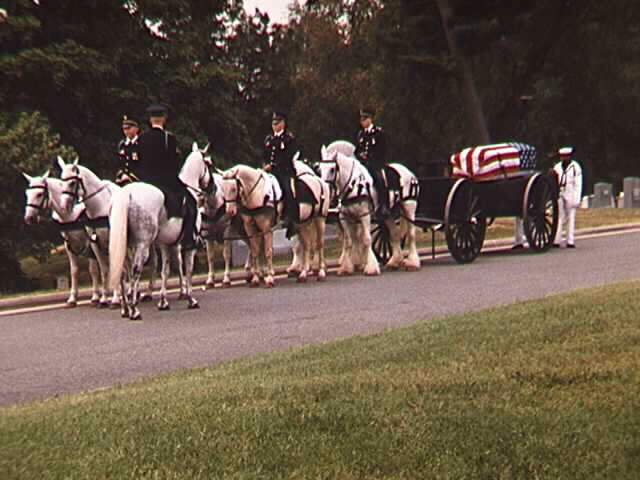


The silence of a military funeral procession is broken only by the rhythmic clip-clop of the seven handsome horses. Astride four of the horses, soldiers sit ramrod straight and stiff. The horses, heads erect, bodies taut and controlled, seem to imitate the solemn military bearing of the men and women who sit quietly in the saddles.
Six of the horses pull a flag-draped casket on a black artillery caisson. Soldiers and horses are conscious that this is no ordinary ride along a cool, shady country lane. They have the honor of carrying a comrade for a last ride to Arlington National Cemetery, to rest in peace with other honored dead.
The solemn dignity the soldiers and horses lend to this ceremony is neither accidental or instinctive. The soldiers and horses constantly train for this duty. They are members of the Caisson Platoon of the 3rd U.S. Infantry Regiment (The Old Guard).
Most of these men and women come to Fort Myer, Va., not as expert horsemen but as trained infantrymen or military-police officers. A new soldier on this team must undergo rigorous training. In addition to caring for the horses, he or she must learn to ride at the erect posture of solemn military attention, sitting in a McClellan saddle.
The caissons that are used were built in 1918. Originally they were used to carry 75mm cannons and were equipped with ammunition chests, spare wheels and tools. Today, these have been removed and replaced with a flat deck on which the casket rests.

The horses used by the Caisson Platoon are the only remaining official Army horses. Although they are normally "saddle-broken" before their arrival at Fort Myer, they require extensive additional training to work with the caisson.
Four teams of horses make up the caisson: one small team of white Lippizans, one team of white English Shires and a team of black English Shires, and one team of black Morgans. All of the horses were donated by various sources across the United States.
During a funeral procession, six horses of the same color (black or gray) make-up the team that pulls the flag-draped coffin upon the caisson through Arlington National Cemetery. They are paired into three teams; the lead team in front, the swing team follows and nearest the caisson is the wheel team. Although all six animals are saddled, only those on the left have mounted riders. This is a tradition that began in the early horse-drawn-artillery days when one horse of each team was mounted, while the other carried provisions and feed.
The riders are dressed in the Army Blue uniform with riding breeches, and boots with spurs. To the left front of the lead team, on a separate mount, rides the section chief who commands the caisson unit.
In addition to their duties in military funerals, the Caisson Platoon sometimes participates in historic pageants performed by The Old Guard.
One of the older traditions in a full-honor funeral is the caparisoned (riderless) horse. The horse is led behind the caisson, wearing an empty saddle with the rider's boots reversed in the stirrups. This indicates the warrior will never ride again.
Tradition allows a caparisoned horse to follow the casket of any military commissioned officer in the rank of colonel or above. Presidents of our nation, as commanders-in-chief, are given the same honor.
The most famous caparisoned horse was Black Jack. He was foaled Jan. 19, 1947, and was the last of the Quartermaster-issue horses branded with the Army's "US" brand. He was named after Gen. of the Armies John J. "Black Jack" Pershing. He participated in the funerals of presidents John F. Kennedy, Herbert Hoover and Lyndon Johnson, Gen. of the Army Douglas MacArthur and thousands of other funerals during his 24 years of service with The Old Guard. Upon his death, Feb. 6, 1976, he was buried on the parade field at Fort Myer.



